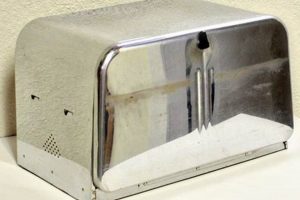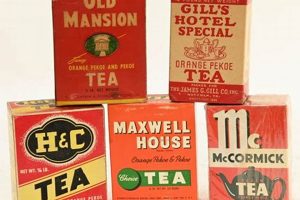These discarded containers, once holding cleaning agents for household use, are now collectible artifacts. Examples include vibrant, lithographed cardboard packages from brands like Tide, Oxydol, and Rinso, often dating from the mid-20th century. Their aesthetic appeal and connection to a bygone era contribute to their desirability.
The significance of these items lies in their ability to represent shifts in consumer culture, advertising techniques, and design trends. The graphics, typography, and marketing messages displayed on these containers provide insights into the social values and technological advancements of their respective periods. Moreover, they serve as tangible links to personal and collective memories, evoking nostalgia for simpler times and familiar household routines.
The subsequent sections will delve into the factors influencing the collectibility of these packaging items, the methods for authenticating and preserving them, and the resources available for enthusiasts and researchers seeking to expand their knowledge in this area of material culture. Understanding these aspects enhances appreciation and facilitates informed engagement with the historical artifacts.
Guidance on Acquiring Historical Cleaning Agent Containers
The acquisition and preservation of vintage laundry detergent boxes necessitate a meticulous approach. Ensuring authenticity and maintaining condition are paramount.
Tip 1: Research Branding and Eras: Prior to acquisition, thorough research of manufacturers, logos, and design styles associated with particular decades is crucial for identifying genuine pieces. Period advertisements and catalogs serve as valuable references.
Tip 2: Evaluate Condition Carefully: Assess structural integrity and surface condition. Signs of significant damage, such as tears, crushing, or water damage, negatively impact value. Minor wear commensurate with age may be acceptable.
Tip 3: Verify Printing Techniques: Examine the printing methods used. Lithography, common in earlier examples, exhibits a distinct texture and color quality compared to modern printing. Variations in printing techniques can suggest authenticity or reproduction.
Tip 4: Scrutinize Closures and Seams: Original closures, whether glued, stapled, or folded, should align with manufacturing standards of the period. Any signs of tampering or unprofessional repair should raise concerns.
Tip 5: Cross-Reference with Known Examples: Compare potential acquisitions with documented examples in established collections or reputable online archives. This comparative analysis helps to identify anomalies or inconsistencies.
Tip 6: Seek Expert Appraisal: For high-value items, consult with an experienced appraiser specializing in ephemera or advertising collectibles. Professional valuation provides independent confirmation of authenticity and fair market value.
Tip 7: Understand Storage Requirements: Protect acquired containers from direct sunlight, excessive humidity, and temperature fluctuations. Acid-free storage materials and archival-quality display cases are recommended to prevent degradation.
Adhering to these guidelines will maximize the potential for acquiring genuine items and preserving them for future study and appreciation. The value rests not only in the artifacts themselves, but in their accurate representation of consumer history.
Subsequent sections will cover specific strategies for cleaning, restoring, and exhibiting these preserved examples of material culture.
1. Aesthetics
- Color Palettes and TypographyThe selection and application of colors and fonts on these boxes were deliberate choices intended to capture consumer attention and convey specific messages. The vibrant, often saturated hues common in mid-century examples reflect a post-war optimism and a desire for modernity. Bold, geometric typefaces were frequently used to project a sense of efficiency and technological advancement. Later examples may feature more muted tones and rounded fonts, indicating a shift towards environmental awareness and softer, more approachable branding.
- Illustrations and ImageryIllustrations played a crucial role in conveying the perceived benefits of the detergents and associating them with desirable lifestyles. Images of idealized housewives, pristine laundry, and smiling children were commonplace, reinforcing traditional gender roles and domestic values. The style of these illustrations, ranging from realistic renderings to stylized graphics, reflects the prevailing artistic trends of the time. The evolution of imagery on these boxes provides a visual timeline of changing societal expectations.
- Layout and CompositionThe arrangement of visual elements on the boxes, including the placement of logos, product names, and descriptive text, was carefully considered to create a visually appealing and informative package. Symmetrical layouts and clear, concise messaging were favored in early examples, while later designs often incorporated more dynamic compositions and elaborate branding. The overall design of the box was intended to attract shoppers in a competitive retail environment and differentiate the product from its rivals.
- Material and TextureThe tactile experience of the boxes also contributes to their aesthetic appeal. The smooth, glossy surface of lithographed cardboard, the rough texture of corrugated cardboard, and the feel of embossed lettering all contribute to the sensory experience of handling these items. The physical properties of the materials used reflect the technological capabilities and economic constraints of the era, adding another layer of historical context.
These aesthetic elements, when analyzed collectively, transform what was once a disposable container into a valuable artifact. They allow contemporary observers to glean insights into the visual culture, consumerism, and social values of past generations. The aesthetic appeal of these detergent boxes provides a direct connection to a bygone era, making them highly sought-after collectibles.
2. Materiality
The shift towards lighter, less expensive materials, such as thinner cardboard and plastic films, reflects evolving manufacturing processes and cost-saving measures. While these later materials reduced production expenses, they also diminished the durability of the boxes. Boxes constructed from such materials are generally more susceptible to tearing, crushing, and fading, leading to a lower survival rate and reduced market value. The presence of plastic components, while sometimes enhancing water resistance, introduces concerns regarding plastic degradation and its environmental impact. The material composition, therefore, provides valuable insights into the economic and technological context of the detergent’s production.
Understanding the materiality of these containers is crucial for proper handling, storage, and conservation efforts. Implementing appropriate preservation techniques, such as acid-free storage and climate control, can mitigate the effects of material degradation and extend the lifespan of these artifacts. Furthermore, analyzing the materials used in their construction allows for more accurate dating and authentication, aiding collectors and researchers in their pursuit of understanding consumer culture and advertising history. Recognizing the interplay between material properties and environmental factors ensures informed stewardship of these remnants of the past.
3. Branding
Analyzing the branding strategies employed on these boxes reveals practical applications for contemporary marketing. The use of vivid colors, bold typography, and aspirational imagery continues to resonate with consumers. Examining the evolution of branding, from straightforward claims of superior cleaning ability to more nuanced appeals to emotional needs, demonstrates the adaptability of marketing principles. For example, later boxes often incorporated environmental messaging, reflecting a growing consumer awareness of sustainability. Comparing the branding approaches of different brands, such as Oxydol versus Rinso, highlights the competitive landscape of the detergent industry and the diverse strategies used to differentiate products. These insights enable marketers to refine their own approaches and develop more effective campaigns.
In summary, the branding on vintage laundry detergent boxes serves as a tangible record of advertising history and consumer culture. Challenges in interpreting this branding arise from the potential for misinterpretation due to evolving social norms and advertising regulations. Nevertheless, the study of branding within this context provides a valuable lens for understanding the complex relationship between products, consumers, and the broader cultural landscape. This understanding links directly to the broader theme of material culture and the role of everyday objects in shaping collective memory.
4. Scarcity
- Limited Production RunsDetergent boxes produced during brief periods or as limited editions command higher prices due to their inherent rarity. For example, promotional boxes released for specific events or those featuring unique designs often had restricted production numbers. The inherent limited supply, coupled with collector demand, elevates their status and increases their market value. Documentation verifying the limited release further enhances their appeal.
- Regional AvailabilityBoxes distributed exclusively in certain geographic regions are scarcer in other areas, making them more desirable to collectors residing outside of the original distribution zone. A brand test-marketed in a specific state, for instance, would be less common in nationwide collections. Collectors often actively seek out these regionally specific items, expanding their collections and increasing the value of these localized examples. The cost of acquiring these boxes often includes shipping and related expenses.
- Low Survival RatesLaundry detergent boxes, typically viewed as disposable containers, were rarely preserved intentionally. The vast majority were discarded after use, leading to a low survival rate for many designs. Boxes from earlier eras, predating widespread collector interest, are particularly scarce due to natural degradation and a lack of conscious preservation efforts. The condition of surviving examples also impacts their scarcity, with well-preserved boxes being more valuable than damaged or incomplete ones.
- Brand and Design SpecificsCertain brands or designs, due to shorter market lifespans or limited appeal, are inherently scarcer than more popular or enduring examples. A detergent box featuring a controversial advertising campaign, for example, might have been discontinued relatively quickly, resulting in a lower number of surviving examples. Similarly, boxes with unique or elaborate designs may have been more expensive to produce, leading to smaller production runs and increased rarity. Collectors often specialize in specific brands or designs, further concentrating demand on these scarce items.
The interplay of these factors determines the relative scarcity of individual examples of vintage laundry detergent boxes. The heightened desire for rare boxes drives collector enthusiasm and fuels the market for these ephemeral artifacts. Understanding the factors contributing to scarcity is essential for collectors seeking to acquire valuable and historically significant pieces.
5. Condition
- Structural IntegrityThe overall soundness of the box, including its shape, seams, and closure mechanisms, directly affects its desirability. Examples exhibiting crushing, tearing, or water damage possess diminished value. A box retaining its original form and structural stability is highly prized. The absence of significant structural flaws indicates careful storage and handling throughout its history, adding to its collectibility.
- Surface QualityThe condition of the printed surfaces, including the presence of fading, staining, or discoloration, impacts the visual appeal and readability of the branding elements. Boxes with vibrant colors and intact graphics are more desirable. The presence of scratches, abrasions, or adhesive residue detracts from the box’s aesthetic qualities. Proper storage away from direct sunlight and moisture is crucial for maintaining surface quality.
- CompletenessThe presence of all original components, such as inner liners, promotional inserts, or attached coupons, enhances the value of the box. A complete and unopened box represents the pinnacle of collectibility, offering a glimpse into the original consumer experience. The absence of these components reduces the historical context and market value. Collectors often seek out complete examples to gain a more comprehensive understanding of the product and its marketing.
- Restoration and AlterationsAny attempts to repair, clean, or alter the box must be carefully scrutinized. While minor repairs may be acceptable, extensive restoration can diminish the box’s authenticity and historical value. Alterations, such as the removal of labels or the application of protective coatings, can negatively impact its collectibility. Transparency regarding any restoration efforts is essential for maintaining ethical collecting practices.
These considerations underscore the central role of condition in evaluating vintage laundry detergent boxes. Boxes in pristine or near-pristine condition command significantly higher prices and are more likely to be preserved for future generations. The assessment of condition requires careful examination and an understanding of the factors that contribute to the degradation of these artifacts.
6. History
Understanding the historical timeline of these boxes facilitates a deeper comprehension of their collectibility and value. Knowledge of key events, such as the introduction of synthetic detergents, the rise of mass media advertising, and the emergence of environmental awareness, allows collectors and researchers to contextualize specific designs and brands. For example, the introduction of enzyme-based detergents in the 1960s led to a wave of new marketing claims and packaging innovations, reflecting the technological advancements of the time. Similarly, the growing environmental movement in the 1970s prompted some manufacturers to adopt more eco-friendly packaging materials and promote the biodegradability of their products. The historical evolution of packaging materials and advertising themes provides invaluable insights into the changing priorities of both manufacturers and consumers.
In conclusion, the historical dimension of vintage laundry detergent boxes is crucial for appreciating their broader cultural and economic significance. While potential exists for selective interpretation or the overemphasis of specific historical narratives, careful analysis of packaging designs, advertising claims, and material compositions offers a valuable lens through which to examine the evolving relationship between products, consumers, and society. This historical perspective enriches the understanding of material culture and provides a tangible link to past generations.
Frequently Asked Questions
The following addresses common inquiries regarding the acquisition, preservation, and historical significance of these artifacts.
Question 1: What factors determine the value of a vintage laundry detergent box?
Several elements contribute to valuation, including age, brand, design, scarcity, condition, and historical context. Boxes from lesser-known brands or those with unique designs often command higher prices. Condition remains paramount; examples in pristine or near-mint condition are more desirable than those with significant damage or wear.
Question 2: How can the authenticity of a vintage laundry detergent box be verified?
Authenticity verification requires meticulous examination of printing techniques, materials used, and design elements. Comparing the box to documented examples in reputable sources or consulting with experienced appraisers specializing in ephemera is recommended. Discrepancies in printing quality, construction, or branding may indicate reproduction.
Question 3: What are the best methods for preserving vintage laundry detergent boxes?
Optimal preservation involves storing boxes in a cool, dry environment away from direct sunlight. Acid-free storage materials and archival-quality display cases are recommended to prevent degradation. Handling should be minimized, and protective gloves should be worn to avoid transferring oils or contaminants to the surface.
Question 4: How should vintage laundry detergent boxes be cleaned?
Cleaning should be approached with extreme caution, as harsh chemicals or abrasive methods can damage the box. Gentle dusting with a soft brush is typically sufficient. If more extensive cleaning is necessary, consult with a professional conservator specializing in paper or cardboard artifacts.
Question 5: Where can vintage laundry detergent boxes be purchased?
These containers can be found at antique stores, flea markets, online auction sites, and specialized ephemera shows. Reputable dealers specializing in vintage advertising or packaging offer a reliable source for acquiring authenticated examples. Due diligence is essential to ensure authenticity and fair pricing.
Question 6: Are there resources available for learning more about vintage laundry detergent boxes?
Numerous resources exist for further research, including books on advertising history, online databases of vintage packaging, and collector societies dedicated to ephemera. Museums with collections of household artifacts or advertising memorabilia may also provide valuable information and context.
The preceding questions offer a foundational understanding of key aspects related to these historical artifacts. Adherence to these guidelines facilitates informed engagement and responsible stewardship.
The subsequent section will address specific case studies of prominent brands and designs, further illustrating the cultural and commercial significance of vintage laundry detergent boxes.
Conclusion
This examination has revealed that vintage laundry detergent boxes transcend their original function as mere containers. They serve as tangible records of evolving consumer culture, advertising strategies, and household practices throughout the 20th century. Their value lies not only in their scarcity and condition but also in their ability to illuminate the past, offering insights into design aesthetics, material technologies, and societal values.
Continued research and preservation efforts are essential to safeguard these artifacts for future generations. By recognizing their historical significance, collectors, historians, and enthusiasts can contribute to a deeper understanding of material culture and the enduring influence of everyday objects on shaping collective memory. Their study encourages a reevaluation of the relationship between consumerism, design, and the evolving human experience.




![Buy Vintage Peanuts Lunch Box [Collectible Box] Vintage Treasures: Discover Rare Antiques, Collectibles & Retro Finds Buy Vintage Peanuts Lunch Box [Collectible Box] | Vintage Treasures: Discover Rare Antiques, Collectibles & Retro Finds](https://roopevintage.com/wp-content/uploads/2025/11/th-869-300x200.jpg)


